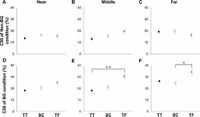Table tennis (TT) players have displayed enhanced visual motion direction discrimination (MDD) abilities compared to athletes in other sports such as soccer (SC) and track and field (TF), suggesting that exposure to specific visual environments can significantly impact motion perception.
A recent study, published on March 23, 2025, investigated the visual motion abilities of collegiate athletes within these different sports. Conducting tests using random dot kinematograms, the researchers compared how well TT players and SC players could discern moving dot patterns against a backdrop of random motion, highlighting how the demands of their sports led to specialized visual adaptations.
Researchers noted that TT players outperformed TF athletes at near-peripheral vision, which is crucial during a match when tracking the fast-moving ball. The study found TT players had significantly better motion sensitivity in regions of the visual field more frequently utilized during gameplay. Conversely, SC players excelled in far-peripheral vision, which aligned with their need to be aware of a broader visual field, including the movements of opponents.
“This study highlights the adaptability of perceptual learning specific to the distinct demands of various sports,” stated the authors of the article. “Our findings emphasize the critical importance of experience in shaping visual discrimination capabilities.”
Through motion direction discrimination tasks that measured thresholds for detecting motion, the study categorized athletes based on their sport-specific visual experiences. TT players demonstrated superior MDD in near-peripheral areas, while SC players showed advantages in far-peripheral regions under conditions involving background noise.
The experiment analyzed the performance of university-level athletes, categorized as follows: TT players aged 19.5 years with an average of 8 years of experience, SC players aged 19.0 years with about 14 years of experience, and TF athletes aged 19.5 years with 7 years of experience. The tasks involved displaying visual stimuli on a high-resolution liquid crystal display while fixing participants' heads to maintain focus.
In assessing motion coherence sensitivity, researchers noted that the special requirements of each sport led to differentiated visual competencies. For instance, the increased motion coherence threshold for TF athletes indicated a less refined visual adaptation compared to their ball sport counterparts.
Interestingly, both TT and SC players attained lower motion coherence thresholds compared to TF athletes when background noise is present. This finding highlights how athletes engage in figure-ground segregation, enabling them to isolate relevant motion—such as a ball—from distracting movements around them, which is vital for success in competitive play.
“Under challenging conditions with background noise, players from ball sports have shown acute awareness of significant motion signals despite the distractions,” the authors of the article remarked.
Background noise posed a particular challenge, requiring athletes to distinguish coherent motion signals amid a crowded visual environment. This is consistent with findings from previous studies indicating that such distractions diminish motion detection capabilities.
The results of this research reflect the training athletes undergo in their respective sports, contributing to enhanced capabilities in visual motion discrimination relevant to their sporting context. This adaptation is attributed to the regular exposure and specific visual challenges that are inherent in competitive sports.
Understanding these dynamics can help optimize training programs, suggesting avenues for improving athletic performance not just through physical training but also via visual perceptual exercises tailored for specific sports.
The research underscores the importance of recognizing how sport-specific training can result in material enhancements in visual function. Findings suggest that examination of visual skills in athletes could lead to greater insights into the adaptations that stem from training and competition.
Future research may explore the underlying neural mechanisms responsible for these visual enhancements, potentially revealing ways to further refine training regimens to capitalize on perceptual learning advantages. Given the implications for athlete training, these findings push the boundaries of how we understand skill acquisition in sports.




